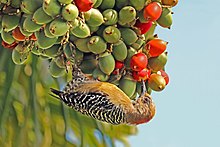Piciform
| Piciformes Temporal range: Early Eocene to present |
|
|---|---|
 |
|
| Red-crowned woodpecker Melanerpes rubricapillus rubricapillus female, Tobago |
|
| Scientific classification | |
| Kingdom: | Animalia |
| Phylum: | Chordata |
| Class: | Aves |
| Clade: | Picodynastornithes |
| Order: |
Piciformes Meyer & Wolf, 1810 |
| Suborders and families | |
|
For prehistoric taxa, see text |
|
| Synonyms | |
|
Galbuliformes Fürbringer, 1888 |
|
For prehistoric taxa, see text
Galbuliformes Fürbringer, 1888
Nine families of largely arboreal birds make up the order Piciformes, the best-known of them being the Picidae, which includes the woodpeckers and close relatives. The Piciformes contain about 71 living genera with a little over 450 species, of which the Picidae (woodpeckers and relatives) make up about half.
In general, the Piciformes are insectivorous, although the barbets and toucans mostly eat fruit and the honeyguides are unique among birds in being able to digest beeswax (although insects make up the bulk of their diet). Nearly all Piciformes have parrot-like zygodactyl feet—two toes forward and two back, an arrangement that has obvious advantages for birds that spend much of their time on tree trunks. An exception are a few species of three-toed woodpeckers. The jacamars aside, Piciformes do not have down feathers at any age, only true feathers. They range in size from the rufous piculet at 8 centimetres in length, and weighing 7 grams, to the , at 63 centimetres long, and weighing 680 grams. All nest in cavities and have altricial young.
The Galbulidae and Bucconidae are often separated into a distinct Galbuliformes order. Analysis of nuclear genes confirms that they form a lineage of their own, but suggests that they are better treated as a suborder. The other families form another monophyletic group of suborder rank, but the barbets were determined to be paraphyletic with regard to the toucans and hence, the formerly all-encompassing Capitonidae have been split up. The woodpeckers and honeyguides are each other's closest relatives. According to some researchers, the entire order Piciformes should be included as a subgroup in Coraciiformes.
...
Wikipedia
